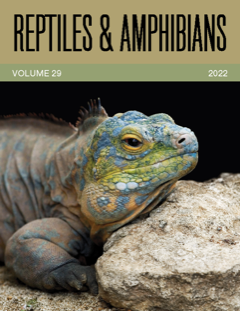Using the iNaturalist application to identify reports of Green Iguanas (Iguana iguana) on the mainland United States of America outside of populations in Florida
DOI:
https://doi.org/10.17161/randa.v29i1.16269Keywords:
citizen science, exotic pets, invasive species detectionAbstract
Presently, the only established populations of invasive Green Iguanas (Iguana iguana) on the mainland USA occur in Florida. We examined observation data from the online citizen-science application iNaturalist to determine the frequency of reports of free-living Green Iguanas in Florida and identify where iguanas have been reported in other parts of the mainland USA. Observations from Florida comprised 99.6% of the 5,929 verified Green Iguana observations from the mainland USA. The largest proportion were observations from 2016 to 2021, corresponding with an increasing number of application users contributing to the dataset during this period. The majority of Green Iguana observations from latitudes of 27–41°N in 11 other mainland states were from California. However, we noted no obvious concentrations of sightings to indicate the presence of established populations in any of those 11 states. The majority of observations from outside Florida were adults and were most frequently reported from suburbia and urban parks, suggesting that released or escaped pets were the likely source. More than one third of iguanas reported outside Florida were near water, which is worrisome because iguanas are known to use waterways to disperse. This study clearly demonstrates the value of public participation in assembling sighting records of non-native animals, and we encourage engagement campaigns that leverage reports from members of the public to achieve early detections of potentially invasive species.
Downloads
Published
Issue
Section
License
Copyright (c) 2021 Matthew Mo, Elouise Mo

This work is licensed under a Creative Commons Attribution-NonCommercial 4.0 International License.
Copyright is held by the authors. Articles in R&A are made available under a Creative Commons Attribution-NonCommercial 4.0 International license.

